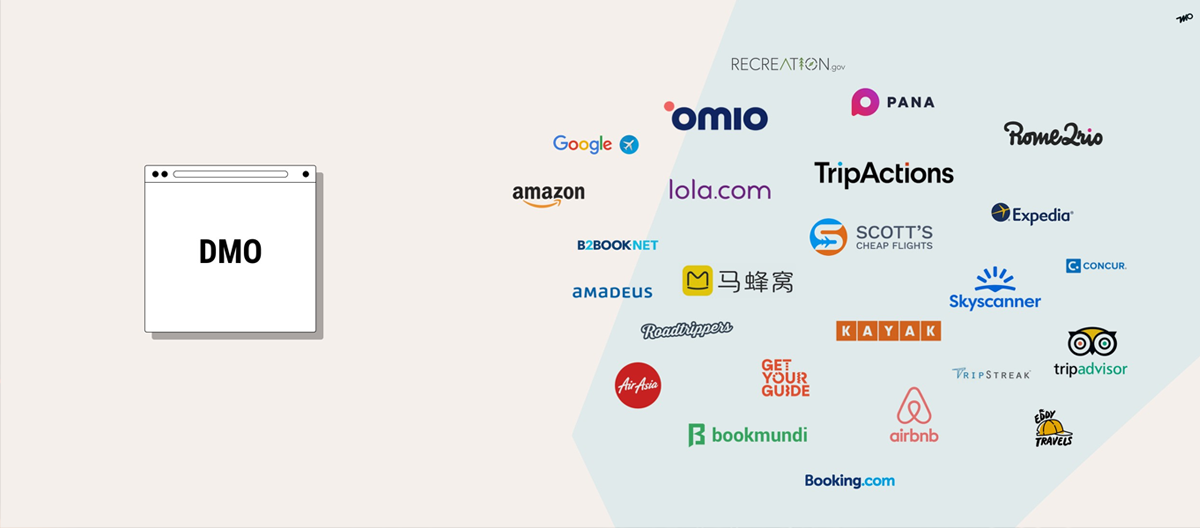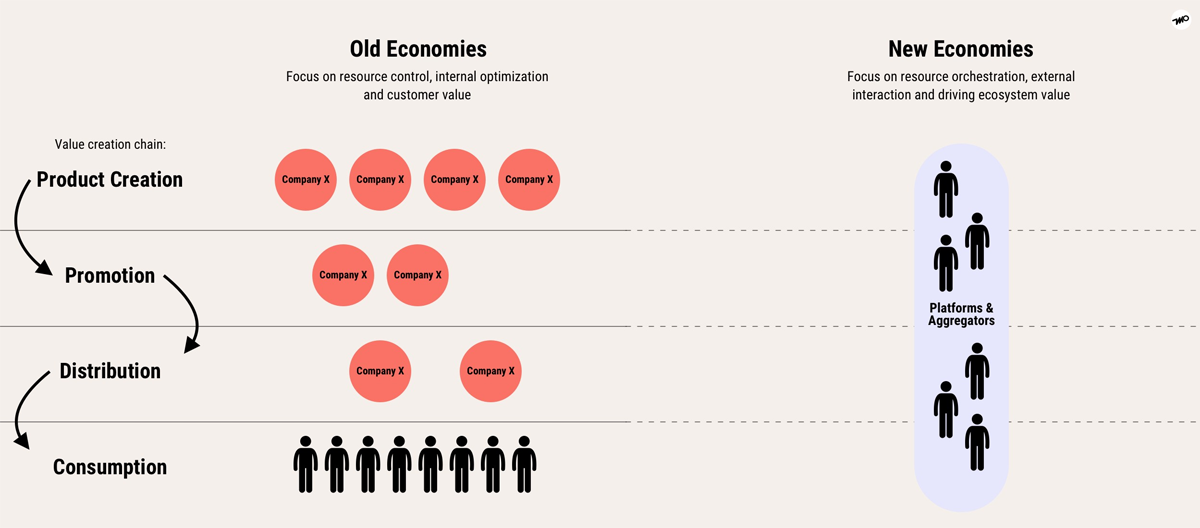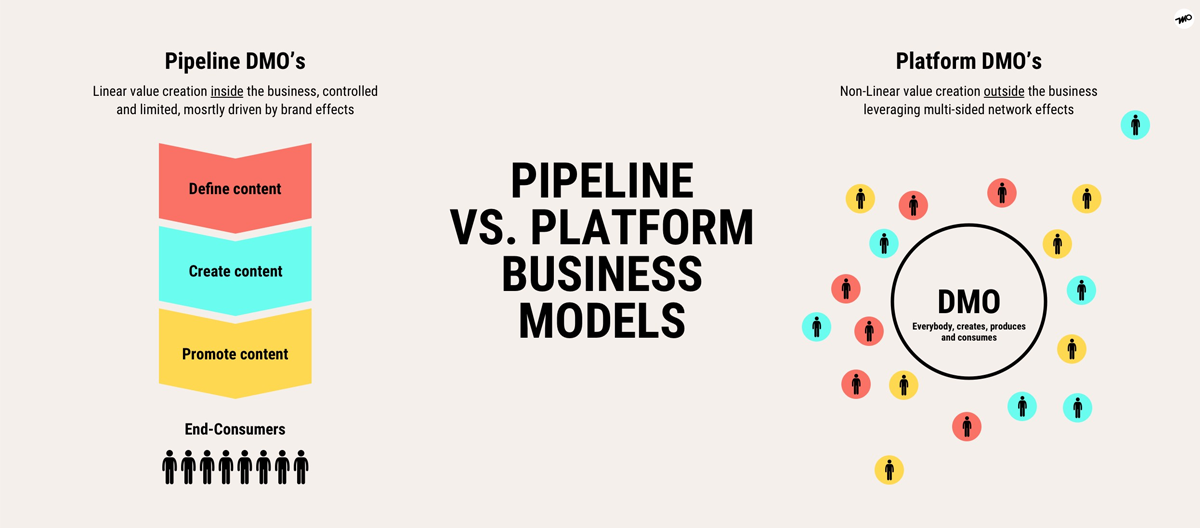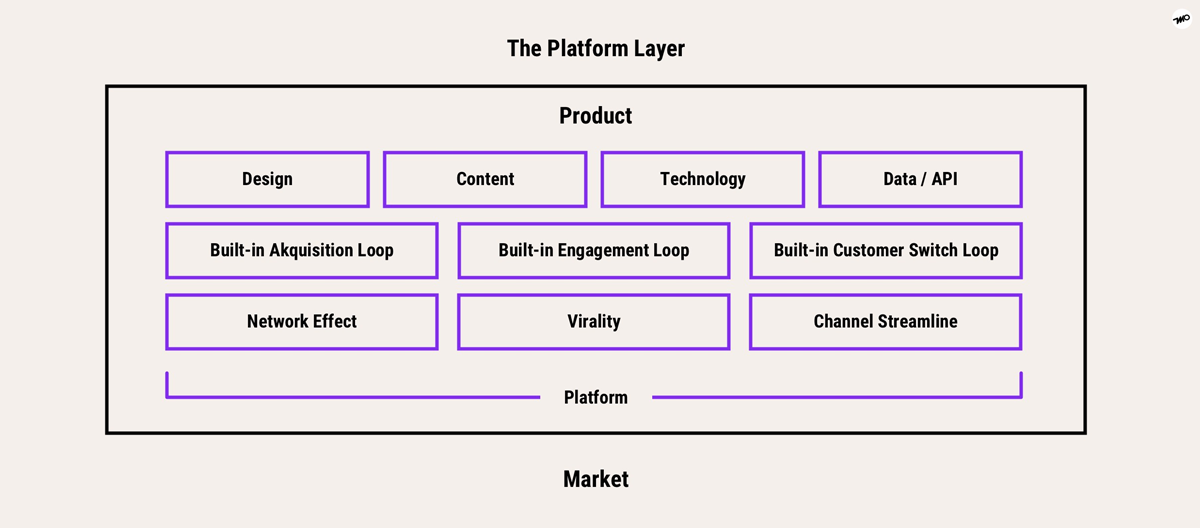The rapid expansion of the Internet into rural areas, the easy accessibility and creation of commodified digital travel services and the fluid adoption of ubiquitous mobile and network technologies unleashed new business challenges for traditionally slow-moving, brand-lead Destination Marketing Organizations (DMOs). New, customer-centric and web-enabled startups are leading users attention away from static, anonymous, program-driven website directories to utility-driven, community-enabled interoperating platform economies. Mediated by technology — consumers become content producers and vice versa, generating value as a two-way participatory act while exploring the world, meeting people and forming new relationships, that benefit themselves and organizations that orchestrate these interactions.
In this article, we examine key platform characteristics, conceptualize opportunities for DMOs to participate in the rapidly growing platform and online aggregator economy and outline how the DMOs and DMO tourism industry value creation chain for its online outlet needs to be redesigned from scratch. This write-up reflects an ongoing thought-process (not an end-point) about the future of a tech empowered travel industry.

Key Points
- The digital travel economy is dominated already by online platforms.
- In the online world, the distinction between ‘producer’ and ‘consumer' of travel experiences is increasingly blurred.
- Platform-enabled businesses are taking over travellers' attention and changing their behaviour online. These new value-creation ecosystems not only stimulate user engagement but unleash new product and service creation at a rapid scale that outperforms DMO capabilities.
- DMO’s business models and the way they create value need to change to shake off the threat of becoming irrelevant.
- Done right, digital-first business models can generate new revenue for DMOs and DMO tourism, while building strong community ties and managing their destinations.
The Platform Threat
Over the past two decades, some of the most profitable and successful firms are those that have adopted a digital platform model — a strategy whereby the company allows two or more disparate groups to interact over a platform to co-create value. For example, landlords/hosts and short-term renters on Airbnb, local tour-guides and foreign adventure seekers on GetYourGuide, drivers and ride-hailers on Uber, business travel suppliers and corporate clients on TripActions or Lola, and local tour-operators and group travellers on Bookmundi or KimKim – just to name a few. These companies capture and orchestrate demand and supply in the most efficient ways through multi-sided network effects and in doing so, attract large amounts of dedicated users.

In today’s networked age, the cloud, social media, and mobile devices are fuelling the platform competition, and more and more companies want to get in as it promises superior user experience, direct relationship with the customer, low acquisition costs and new (digital) revenue streams. However, many organizations are not able to move at hypersonic speed and do not succeed in becoming platform leaders because their technology, skills, business models and organizational structures fall short. DMOs are no exception.
My prediction is, sooner or later, travel-related platforms will control and own all stages of the (online) travel service funnel, starting from capturing demand, discovery, trust establishment, B2B communication, production of travel products, distribution, booking, transaction, consumption, active oversight of service delivery, stewardship, all the way back to loyalty, (big) data collection and all the little service and innovation stages in between. In addition, few of the global giants like Amazon, Facebook and Google are likely to push into hospitality and tourism more aggressively within the next two years. And when it comes to data ownership, the large internet platforms are in a dramatically different league than everyone else. This begs the question for me; after this digital pie has been sliced, will there be anything left for DMOs to do?

The Platform Threat is real and it’s about time for DMOs to prepare for a major business transformation, otherwise local, regional and perhaps even national level independent platform-enhanced communities of value producers and consumers will have taken the larger share of new digital revenue and engagement opportunities that drive peoples’ and investors’ attention away from slow-moving, often inward-focused DMOs.
DMOs as Platforms
Many DMO leaders are hoping that Artificial Intelligence (AI) or smart APIs will help increase online relevancy (DestinationNext 2019 Survey) perhaps through better personalization, automation and improved speed. However, simply adding a tech layer to your teams’ or partners’ digital outlets and touchpoints won’t shift the needle far enough. Competing with web-enabled platforms and adapting an outdated business model requires changing the operational layers and changing the way you create value in the first place.
DMOs still set their strategic priorities in a somewhat wrong order, with Destination Marketing ranking as priority #1, Destination Management as priority #2, Community Engagement #3 and lastly, Organization Operations #4. To successfully compete with highly connected, platform-enabled companies, DMOs first and foremost need to be concerned about how to adapt their business- and operational model, so the value creation chain moves away from a linear pipeline- to a network-driven platform model. Organizational and digital transformation needs to be a top priority for 2020/21 — so you simply need to think of yourself as a pure tech company. But how to do this and where to start, especially when you are a small team or manage a tiny region?
DMOs need to be driven by network effects, not by brand-effects nor travel products. Building tech functionality is surpirisingly less important than the ability to enable interactions and establish a strong (online) community. This can be even achieved with an email newsletter.
A First Starting Point
Pipeline businesses, such as DMOs, create value in a linear way. As a first step, these organizations source their inventory (creation), then go through a vetting process (optimization/management) until they eventually promote and expose (market) the curated ‘lists’ of hotels, restaurants, retailers, venues, places and experiences etc.. Value, in a sense, is produced upstream and consumed downstream. Income is generated in multi-faceted ways.
The key problem with this type of value creation is that it is slow — and performance relies heavily on a smaller team's human capacity and their ability to manage — mostly analogue — multiple stakeholders and assets in a controlled, closed ‘ecosystem’. Decisions are made by a few people, often behind closed doors, and performance data is only captured on the demand side, but not on the supply side, because of the analogue value creation chain.
Deep embedded in DMO DNA is also the ability to create –expensive, but effective– brand-effects. Marketing organizations want people to remember places and to associate them with specific feelings, and for those to play into decisions on where to spend the next leisure or business trip. The focus of creating a successful platform, however, should be solely on building strong network effects (push & pull). A multi-sided network effect enhances growth because a product or service becomes more valuable to existing users as more people participate in its usage. The fax machine is an early example of just that.
DMOs who focus more on destination management to some extent do create network effects already, but these network effects happen mostly in a closed system (more members/partners does not equal more visitors and vice versa). In any market with strong signals for multi-sided network effects — e.g. online travel— the focus of a DMO’s attention must shift from inside to outside the organization, from reaching and matching a few to reaching and matching many, simply because you cannot scale network effects inside a closed system as easily as outside of it.
What does all this mean for DMOs? It’s simple; to have a stronger external focus in the value creation chain, DMOs must develop a rock-solid community strategy, going far beyond establishing partner and member networks. A shift needs to happen from:
- Resource control to resource orchestration;
- Internal optimization to external interaction;
- Focus on customer value to focus on ecosystem/community value.
Airbnb’s Experiences are a great example. The company knew that it would be easier and faster to build up inventory (supply) and attract travellers (demand) when they allow everybody to create and host home-made, local experiences catered to people who seek authenticity (community & mission). These numbers confirm Airbnb’s rapid growth; Experiences was launched in 2016 with just over 500 listings in 12 cities. In 2018 they covered 1000 destinations and listed 20,000 active experiences. They added 25,000 more tours and experiences in 2019. How did they do this?
They looked at what people (outside the company) were already doing peer-to-peer and then identified a thriving community of hosts who provide all sorts of local experiences to foreign visitors. Once the value unit was identified, all Airbnb needed to do was to design interactions around this value unit which is – creation, curation, transaction and consumption and lastly – recommendation of experiences. The rest was about building a ‘website/app’ that enables defined interactions effectively.

What can DMOs learn from Airbnb? Few people consider Airbnb as just being an aggregator who built its business on top of an existing industry — it has not transformed the hospitality industry (perhaps local communities to the worse). Nevertheless, this example effectively shows us that Airbnb, as an aggregator and organization, is a modern infrastructure designed to facilitate three kinds of exchange online; information, services and currency.
DMOs need to take note and start asking themselves these key questions:
- What available work and community forces are already in place?
- What do travellers, hosts, our partners, hoteliers, restaurant owners, tour guides retailer travel agents, etc. already do?
- What value unit do people share, most often, when and how?
- Is there a better way to facilitate existing interactions people and communities already perform? What are some time savers, convenience savers, trust savers, etc.?
- What data do we need to capture? What data do we already have?
- Where do we need strategic partners that can help with community building?
If you are concerned with future digital strategies for DMOs, then you should first be looking at ways to establish strong and vibrant online communities. This does not only benefit your own organization but will help develop strong ties to locals and travellers alike on a city, regional and even national level. The tools are already out there and there is no need to reinvent the wheel — the key is to shift your organizational mindset.
------------
We hope this article gave DMO leaders inspiration and food for thought. Stay tuned for more articles from Marc-Oliver Gern where he'll be outlining in further detail some concrete digital platform strategies which will spark some fruitful discussions with online – or in-person – about the future of DMO’s as platform businesses. In the meantime, check out Appnovation's work with Visit California. With a creative and innovative new online destination, Visit California is driving the digital travel revolution, reaching, engaging with and learning from their customers and has seen 133% increase in page views.


